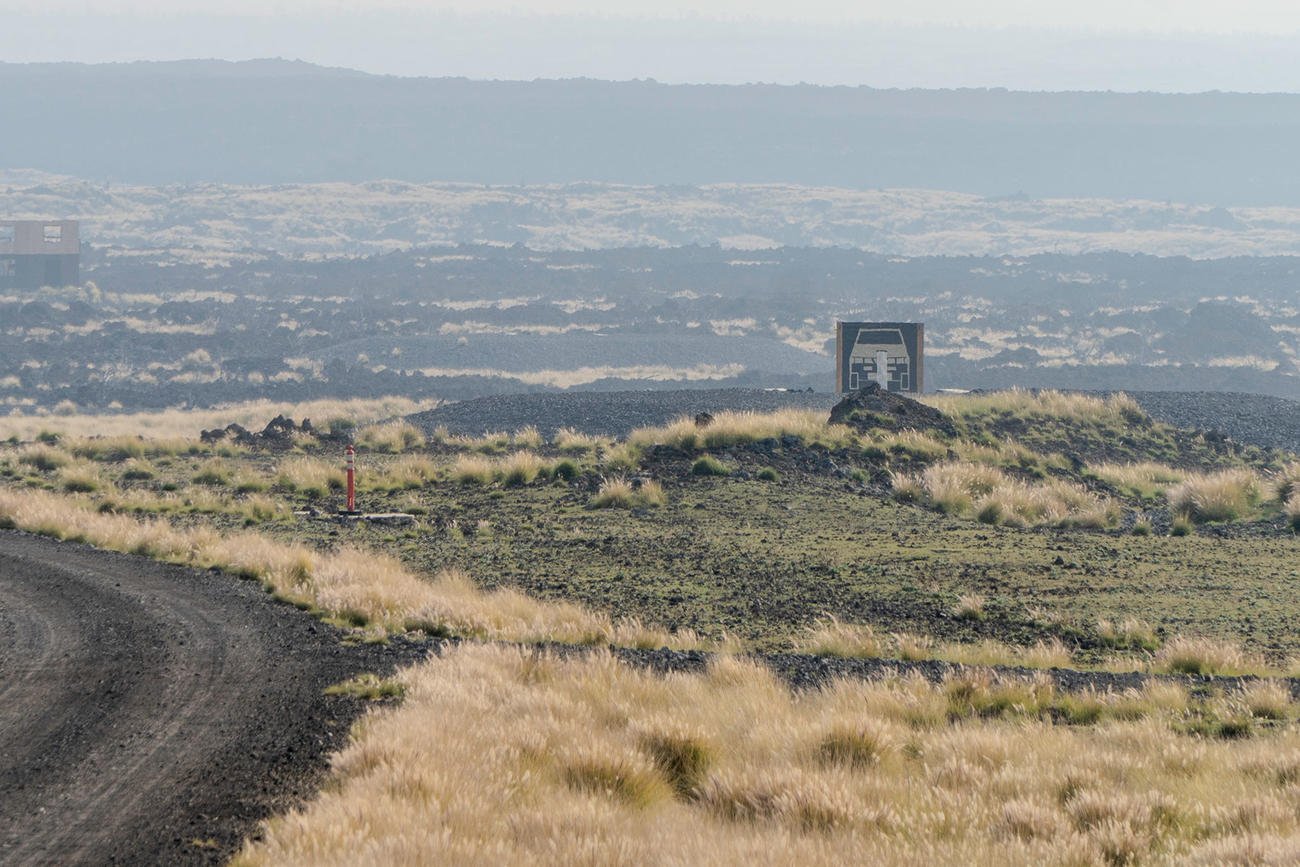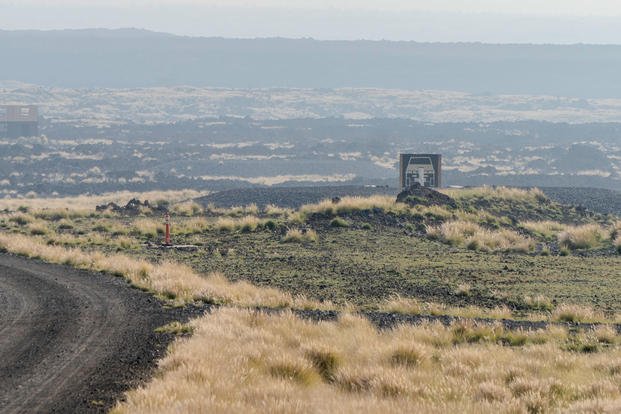

The U.S. Army hit a speed bump in its effort to retain training land in Hawaii with the state Board of Land and Natural Resources voting to reject its final environmental impact statement on its proposal to keep a state-owned parcel at the Pohakuloa Training Area on Hawaii island.
The ruling is an embarrassing setback for the Army after years of working on the document and submitting several drafts since 2022. The many hours of public comment from hundreds of people who turned out to testify both in person and over a Zoom teleconference before the BLNR vote Friday evening overwhelmingly called on the board to reject the EIS and lambasted Army officials.
The public rebuke comes as Army leaders in Hawaii are preparing to host the Land Power in the Pacific Conference this week in Waikiki with a record 32 countries participating and 16 national chiefs of army expected to attend. But it’s not the end of the service’s efforts to retain training land in Hawaii after its leases expire in 2029.
“The issue today is whether we should accept the EIS or not accept the EIS, ” BLNR Chair Dawn Chang said during Friday’s hearing. “It is only with respect to PTA. It is not on whether what the Army is doing is good or bad, or if we provide them land retention or not. So I want to be really clear on what this is, I want to manage everyone’s expectation, including my own and the board.”
The board ultimately concluded that the EIS, the culmination of years of work, contained significant data gaps on potential environmental and cultural impacts, ranging from effects on endangered species, surveys of traditional Native Hawaiian burial grounds, potential threats to groundwater and a litany of other issues raised both by community members and by staff at the Department of Land and Natural Resources who evaluated the document.
Notably, the Army’s most recent biological survey was from 2013, and the service is currently working on a new one expected to be completed this year that takes into account sightings of two previously unaccounted for species at PTA—the yellow-faced bee and Blackburn’s sphinx moth.
The EIS also didn’t address concerns about the handling of funerary artifacts discovered in 2022 that the state and experts consider to be among the most significant archaeological finds in Hawaii’s history.
Office of Hawaiian Affairs Board of Trustees Chair Kai Kahele released a statement Saturday in support of rejecting the EIS.
“This decision reflects a thorough review of the document’s legal, environmental, and cultural deficiencies, many of which OHA and others identified in public testimony, ” he said. “As the State and Hawai ‘i’s Congressional Delegation consider next steps, OHA remains steadfast in its commitment to ensuring that any future course of action honors the unique legal status of these lands and the trust obligations they carry. These lands are not ordinary — they are part of an unrelinquished legacy. OHA will continue to prioritize protecting the rights and interests of the Native Hawaiian people and preserving the integrity of the public land trust.”
Just minutes after the board voted Friday, the Army released its own statement saying, “The Army is currently observing a 30-day waiting period, after which the Army will determine how much land it will seek to retain in its Record of Decision (ROD ). The method of retention, or real estate transaction (lease, fee simple ), would be negotiated with the State of Hawaii after the ROD is confirmed.”
DLNR put out a statement that said, “An EIS is intended to support informed decision-making and does not, by itself, authorize any land use. No decision has been made on the Army’s long-term lease request. A separate review and determination will be required should such a request be brought before the board in the future.”
Staunch opposition The Army has trained in the area since World War II and obtained the parcel at PTA and other land across the islands it uses for training for a mere $1 in 1964. Situated in between Mauna Loa and Mauna Kea, PTA is the U.S. military’s largest contiguous live-fire training area in Hawaii and perhaps the entire Pacific.
The state parcel of 22, 750 acres sits between two federally owned pieces of land, collectively making up 132, 000 acres. Army officials call the leased land “the connective tissue ” of PTA. Lately PTA has become central to the Army’s new Joint Pacific Multinational Readiness Center, a series of training ranges in Hawaii and Alaska aimed at preparing soldiers for operations in the Pacific amid tensions with China.
But the state now considers its parcel at Pohakuloa to be a conservation district, and DLNR staff have concluded that military use of the land is “not consistent ” with that designation.
With its rugged fields of lava rock and volcanic soil, Poha kuloa is classified as a sub-alpine tropical dryland forest — one of the world’s rarest kinds of ecosystems — and is habitat for Hawaii’s state bird, the nene, as well as the hoary bat and several species that exist nowhere else on the planet.
Public responses to the vote rejecting the EIS were swift. Maxx Phillips, Hawaii and Pacific Islands director at the Center for Biological Diversity, said in a statement that “the board saw through the Army’s hollow promises and recognized that you can’t make informed decisions about protecting endangered species, sacred sites or clean water when you refuse to even do baseline surveys. This vote is a powerful affirmation that the future of these lands must be decided with integrity, not rubber-stamped based on incomplete and misleading information.”
A statement from Ashley Obrey, senior staff attorney at the Native Hawaiian Legal Corp., said the BLNR decision “reflects well established Hawai ‘i law that prioritizes the health of Hawai ‘i lands and Native Hawaiian cultural practices over military convenience ” and that “the state has a legal duty to honor the public trust and the rights of kanaka maoli. We commend the board members for standing firm and refusing to accept a document that would have paved the way for another generation of harm to these ‘aina.”
Wayne Tanaka, director of Sierra Club of Hawai ‘i, said, “Pohakuloa has been bombed, burned and polluted for over six decades—and we now have a once-in-a-lifetime chance to finally say no more to such abuse of our ‘aina. Today’s rejection of the final environmental impact statement gives us a fighting chance to restore and protect this sacred place.”
According to a statement from Lt. Col. Tim Alvarado, the officer who oversees day-to-day operations at PTA, the Army in Hawaii “understands and deeply respects the concerns expressed by community members, cultural practitioners, and environmental advocates regarding the Army’s presence and activities at Pohakuloa Training Area. We recognize that past actions have caused harm and eroded trust, and we continue to seek a balance with consideration for the cultural and environmental significance of this land.”
History of litigation In 1989, the Sierra Club sued the Army on behalf of University of Hawaii at Hilo botanist Lani Stemmermann. She had visited an area of dryland forest in PTA in search of research sites to study native plants and found Army bulldozers leveling native naio and mamane trees for a new training range.
In 1993, an Army investigation found planners knowingly cut corners during the survey process, intentionally limited access to scientists and ignored recommendations by Army engineers that called for a comprehensive botanical study of the proposed site.
In 2019, the Hawaii Supreme Court ruled against the state in a lawsuit filed by the Native Hawaiian Legal Corp. on behalf of Hawaiian cultural practitioners Clarence “Ku ” Ching and Mary Maxine Kahaulelio. The court found state officials had failed to ensure the military upheld its duties to clean up Pohakuloa and had harmed Hawaiian cultural interests, and that “as trustee, the State must take an active role in preserving trust property and may not passively allow it to fall into ruin.”
The terms of the Army’s lease state the military must “make every reasonable effort to … remove or deactivate all live or blank ammunition upon completion of a training exercise, ” and disagreement over what “reasonable effort ” means has been an ongoing sticking point.
The military only fires live munitions into PTA’s “impact area, ” which is on federally controlled land. Because it’s considered an active range, the impact area is regarded as too dangerous for regular removal of ordnance. The board as well as several critics who testified noted the EIS did little to evaluate potential impacts of military action on lands surrounding the state parcel.
A small handful of people testified Friday in support of approving the EIS. Matthew Chalker, a Waikoloa Village resident and self-described wildfire safety advocate, said he believes the EIS was thorough and argued that firefighting facilities at PTA have been critical in protecting his community and training other firefighters across the state.
Riley Smith, who represents Hawaii island on the BLNR, opposed the motion to reject the EIS and argued the Army had acted in good faith to provide the best data it could.
BLNR at-large member Vernon Char, who abstained from the vote, said the public testimony “was very one-sided. It was very well-planned and very emotional … many of the statements made today in opposition were very sincere. But some of it, I thought, was misdirected and maybe not really relevant to the issue of whether the EIS should be accepted as having positioned everything, subject to negotiation.”
Negotiations unsure The EIS was largely crafted during the administration of President Joe Biden. With the leases expiring in 2029, future efforts and actual negotiations going forward will be undertaken by President Donald Trump’s Pentagon team, led by Defense Secretary Pete Hegseth.
Army Secretary Dan Driscoll promised U.S. Sen. Mazie Hirono, D- Hawaii, during his Senate confirmation hearing that he would work with her office and community groups in Hawaii on Army land leases and would listen to local concerns about the future of the land.
But while Hegseth has prioritized funding for U.S. forces in the Pacific, he has also vowed to drastically scale back or outright eliminate most of the military’s environmental and cultural programs, charging that such programs are “woke ” and have distracted the military from “warfighting.”
When active training isn’t taking place at PTA, only five uniformed soldiers are stationed there. The rest of the workforce of about 200 people is made up of Army civilians and contractors. Among them are scientists working to catalog and preserve native species living on the base, archaeologists and firefighters tasked with putting out blazes—whether they be natural or caused by military training.
Col. Rachel Sullivan, commander of U.S. Army Garrison Hawaii, said in a statement that “the Army is committed to continuing its environmental and cultural stewardship in support of the U.S. Army Pacific training strategy while maintaining an enduring partnership with the Hawai ‘i Island community.”
However, Hegseth has proposed cutting large portions of the Department of Defense’s civilian workforce, especially any job that doesn’t “directly contribute to lethality, ” such as those working on environmental programs, and has proclaimed that the military is done with “climate crap ” under his watch.
It’s unclear what that will mean in Hawaii as the Trump administration continues to take shape.
© 2025 The Honolulu Star-Advertiser. Visit www.staradvertiser.com. Distributed by Tribune Content Agency, LLC.
© Copyright 2025 Honolulu Star-Advertiser. All rights reserved. This material may not be published, broadcast, rewritten or redistributed.
